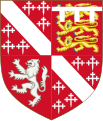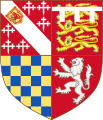Howard family
This article needs additional citations for verification. (May 2010) |
| Howard family | |
|---|---|
Noble family | |
 Coat of arms of Howard, granted to Thomas Howard, 2nd Duke of Norfolk | |
| Country | Kingdom of England, United Kingdom |
| Founded | 1483 |
| Founder | John Howard, 1st Duke of Norfolk |
| Current head | Edward Fitzalan-Howard, 18th Duke of Norfolk |
| Titles | See list
|
| Estate(s) | |
| Cadet branches | |
The Howard family is an
The senior line of the house, as well as holding the title of Duke of Norfolk, is also
Throughout much of
Arundel Castle has been in the family of the Duke of Norfolk for over 400 years, and it is still the principal seat of the Norfolk family. As cultural heritage, it is a Grade I listed building.[1]
Origins

The later Howards would claim legendary descent from
The scroll states, in clear terms, that William Howard de Howard (born 1237) was the second son of Robert Howarth of Howarth, son of William, who was himself the son of Peter de Howard. Dugdale states that William Howard de Howard was the progenitor of the subsequently noble Howard family. William Howard was knighted in c. 1278 and that he was appointed (Chief) Justice of the Common Pleas in 1297. William Howard married firstly Alice de Ufford, the daughter of the Justiciar and Suffolk landowner Sir Robert de Ufford. If Dugdale was correct a young William Howard left Lancashire to settle in Norfolk and practise as a lawyer perhaps at the behest of his father-in-law.[2]
Later in 1636 the Rev. Richard James separately wrote the Iter Lancastrense, a poem on the history of Lancashire in which he mentions "Robin Howorrth, from whose familie Great Noble peers derive their progenie".[3]
Alternatively it is sometimes stated that William Howard is son of a John (Howard) de Wiggenhale, who with other family members appears to have held land in or near Wiggenhall in Norfolk.[4]
Sir
History

Sir William's great-great-great-grandson, Sir Robert Howard, married Lady Margaret Mowbray, elder daughter of
The Howard family became one of the foremost

Both the Dukedom and Earl Marshalship have been the subject of repeated attainders and restorations in the 15th to 17th centuries. Before Charles II restored the titles for good, the Howards had inherited the ancient title of Earl of Arundel through an heiress, and formed additional branches that have continued to this day.
A branch of the Howard family has been seated at Castle Howard, one of England's most magnificent country houses, for over 300 years.
In order of genealogical seniority:
- the Barons Howard of Penrith descend from a younger brother of the 12th Duke;
- the Earls of Suffolk and Berkshire descend from the 2nd son of the 4th Duke;
- the Earls of Carlisle descend from the third son of the 4th Duke;
- the Lord High Admiral and whose son was commander in chief against the Spanish Armada. (Curiously, this line was excluded from eligibility to inherit on the restoration of the Dukedom).
Howard family tree
| Family tree of the Dukes of Norfolk; Earls of Arundel, East Anglia, Norfolk, Norwich, Nottingham, and Surrey; and Barons Mowbray, Segrave and Stourton | |||||||||||||||||||||||||||||||||||||||||||||||||||||||||||||||||||||||||||||||||||||||||||||||||||||||||||||||||||||||||||||||||||||||||||||||||||||||||||||||||||||||||||||||||||||||||||||||||||||||||||||||||||||||||||||||||||||||||||||||||||||||||||||||||||||||||||||||||||||||||||||||||||||||||||||||||||||||||||||||||||||||||||||||||||||||||||||||||||||||||||||||||||||||||||||||||||||||||||||||||||||||||||||||||||||||||||||||||||||||||||||||||||||||||||||||||||||||||||||||||||||||||||||||||||||||||||||||||||||||||||||||||||||||||||||||||||||||||||||||||||||||||||||||||||||||||||||||||||||||||||||||||||||||||||||||||||||||||||||||||||||||||||||||||||||||||||||||||||||||||||||||||||||||||||||||||||||||||||||||||||||||||||||||||||||||||||||||||||||||||||||||||||||||||||||||||||||||||||||||||||||||||||||||||||||||||||||||||||||||||||||||||||||||||||||||||||||||||||||||||||||||||||||||||||||||||||||||||||||||||||||||||||||||||||||||||||||||||||||||||||||||||||||||||||||||||||||||||||||||
|---|---|---|---|---|---|---|---|---|---|---|---|---|---|---|---|---|---|---|---|---|---|---|---|---|---|---|---|---|---|---|---|---|---|---|---|---|---|---|---|---|---|---|---|---|---|---|---|---|---|---|---|---|---|---|---|---|---|---|---|---|---|---|---|---|---|---|---|---|---|---|---|---|---|---|---|---|---|---|---|---|---|---|---|---|---|---|---|---|---|---|---|---|---|---|---|---|---|---|---|---|---|---|---|---|---|---|---|---|---|---|---|---|---|---|---|---|---|---|---|---|---|---|---|---|---|---|---|---|---|---|---|---|---|---|---|---|---|---|---|---|---|---|---|---|---|---|---|---|---|---|---|---|---|---|---|---|---|---|---|---|---|---|---|---|---|---|---|---|---|---|---|---|---|---|---|---|---|---|---|---|---|---|---|---|---|---|---|---|---|---|---|---|---|---|---|---|---|---|---|---|---|---|---|---|---|---|---|---|---|---|---|---|---|---|---|---|---|---|---|---|---|---|---|---|---|---|---|---|---|---|---|---|---|---|---|---|---|---|---|---|---|---|---|---|---|---|---|---|---|---|---|---|---|---|---|---|---|---|---|---|---|---|---|---|---|---|---|---|---|---|---|---|---|---|---|---|---|---|---|---|---|---|---|---|---|---|---|---|---|---|---|---|---|---|---|---|---|---|---|---|---|---|---|---|---|---|---|---|---|---|---|---|---|---|---|---|---|---|---|---|---|---|---|---|---|---|---|---|---|---|---|---|---|---|---|---|---|---|---|---|---|---|---|---|---|---|---|---|---|---|---|---|---|---|---|---|---|---|---|---|---|---|---|---|---|---|---|---|---|---|---|---|---|---|---|---|---|---|---|---|---|---|---|---|---|---|---|---|---|---|---|---|---|---|---|---|---|---|---|---|---|---|---|---|---|---|---|---|---|---|---|---|---|---|---|---|---|---|---|---|---|---|---|---|---|---|---|---|---|---|---|---|---|---|---|---|---|---|---|---|---|---|---|---|---|---|---|---|---|---|---|---|---|---|---|---|---|---|---|---|---|---|---|---|---|---|---|---|---|---|---|---|---|---|---|---|---|---|---|---|---|---|---|---|---|---|---|---|---|---|---|---|---|---|---|---|---|---|---|---|---|---|---|---|---|---|---|---|---|---|---|---|---|---|---|---|---|---|---|---|---|---|---|---|---|---|---|---|---|---|---|---|---|---|---|---|---|---|---|---|---|---|---|---|---|---|---|---|---|---|---|---|---|---|---|---|---|---|---|---|---|---|---|---|---|---|---|---|---|---|---|---|---|---|---|---|---|---|---|---|---|---|---|---|---|---|---|---|---|---|---|---|---|---|---|---|---|---|---|---|---|---|---|---|---|---|---|---|---|---|---|---|---|---|---|---|---|---|---|---|---|---|---|---|---|---|---|---|---|---|---|---|---|---|---|---|---|---|---|---|---|---|---|---|---|---|---|---|---|---|---|---|---|---|---|---|---|---|---|---|---|---|---|---|---|---|---|---|---|---|---|---|---|---|---|---|---|---|---|---|---|---|---|---|---|---|---|---|---|---|---|---|---|---|---|---|---|---|---|---|---|---|---|---|---|---|---|---|---|---|---|---|---|---|---|---|---|---|---|---|---|---|---|---|---|---|---|---|---|---|---|---|---|---|---|---|---|---|---|---|---|---|---|---|---|---|---|---|---|---|---|---|---|---|---|---|---|---|---|---|---|---|---|---|---|---|---|---|---|---|---|---|---|---|---|---|---|---|---|---|---|---|---|---|---|---|---|---|---|---|---|---|---|---|---|---|---|---|---|---|---|---|---|---|---|---|---|---|---|---|---|---|---|---|---|---|---|---|---|---|---|---|---|---|---|---|---|---|---|---|---|---|---|---|---|---|---|---|---|---|---|---|---|---|---|---|---|---|---|---|---|---|---|---|---|---|---|---|---|---|---|---|---|---|---|---|---|---|---|---|---|---|---|---|---|---|---|---|---|---|---|---|---|---|---|---|---|---|---|---|---|---|---|---|---|---|---|---|---|---|---|---|---|---|---|---|---|---|---|---|---|---|---|---|---|---|---|---|---|---|---|---|---|---|---|---|---|---|---|---|---|---|---|---|---|---|---|---|---|---|---|---|---|---|---|---|---|---|---|---|---|---|---|---|---|---|---|---|---|---|---|---|---|---|---|---|---|---|---|---|---|---|---|---|---|---|---|---|---|---|---|---|---|---|---|---|---|---|---|---|---|---|---|---|---|---|---|---|---|
| |||||||||||||||||||||||||||||||||||||||||||||||||||||||||||||||||||||||||||||||||||||||||||||||||||||||||||||||||||||||||||||||||||||||||||||||||||||||||||||||||||||||||||||||||||||||||||||||||||||||||||||||||||||||||||||||||||||||||||||||||||||||||||||||||||||||||||||||||||||||||||||||||||||||||||||||||||||||||||||||||||||||||||||||||||||||||||||||||||||||||||||||||||||||||||||||||||||||||||||||||||||||||||||||||||||||||||||||||||||||||||||||||||||||||||||||||||||||||||||||||||||||||||||||||||||||||||||||||||||||||||||||||||||||||||||||||||||||||||||||||||||||||||||||||||||||||||||||||||||||||||||||||||||||||||||||||||||||||||||||||||||||||||||||||||||||||||||||||||||||||||||||||||||||||||||||||||||||||||||||||||||||||||||||||||||||||||||||||||||||||||||||||||||||||||||||||||||||||||||||||||||||||||||||||||||||||||||||||||||||||||||||||||||||||||||||||||||||||||||||||||||||||||||||||||||||||||||||||||||||||||||||||||||||||||||||||||||||||||||||||||||||||||||||||||||||||||||||||||||||
Arms of the Howard family
The Howard family's original arms were the white bend on red with the crosslets. On marrying the heiress of the dukes of Norfolk, the first Howard duke of Norfolk quartered his arms with those of
-
Howard Arms unaugmented (pre-1513)
-
Arms of Thomas of Brotherton (1300 † 1338), Earl of Norfolk, son of Edward I Longshanks, from whom all the Dukes of Norfolk are descended.Gules, three lions passant guardant in pale or armed and langued azure a label of three points argent.
-
Arms of John Howard, 1st Howard Duke of Norfolk, showing the unaugmented Howard Arms (I & IV), quartering the arms of Thomas of Brotherton (II) and the arms of Mowbray (III): Gules, a lion rampant argent.
-
Arms of Mowbray
-
The coat of arms used by the Howard Family. The Scots shield is an augmentation, see below.[8] Gules, on a bend between six cross-crosslets fitchy argent an escutcheon or charged with a demi-lion rampant pierced through the mouth by an arrow within a double tressure flory counterflory of the first.
-
Augmentation to the arms of Thomas Howard, 2nd Duke of Norfolk for his services at the Battle of Flodden (1513).
-
Arms of the Warrenne Family, Earls of Surrey.
-
Coat of arms of the Howard Dukes of Norfolk, starting with Thomas Howard, 2nd Duke of Norfolk.Quarterly of 4: 1: Howard, with augmentation of honour; 2: Plantagenet, arms of Thomas of Brotherton, 1st Earl of Norfolk; 3: Chequy or and azure (de Warenne, Earl of Surrey); 4: Mowbray
-
Confirmation of arms, crest and supporters, dated 28 May 1580, by Robert Cooke, Clarenceux to Philip Howard, 20th Earl of Arundel, omitting Howard arms and quarterings as the Dukedom of Norfolk was under attainder.
-
Usual quarterings of Howard, Dukes of Norfolk after 1842: with FitzAlan (Gules a lion rampant or) in the 4th quarter, in place of Mowbray; in 1842 the future 14th Duke adopted as a prefix the additional surname of FitzAlan (of Arundel Castle, feudal Earls of Arundel, Barons Mowbray, etc.), whose heiress in 1555 had married Thomas Howard, 4th Duke of Norfolk.
-
FitzAlan, Earls of Arundel.
-
Arms of the arms of Henry Howard, Earle of Surrey, for which he was attainted. The main offense was bearing the undifferenced arms of England (2nd quarter), which only the monarch was allowed. Surrey was beheaded on 19 January 1547 on a charge of treasonably quartering the royal arms.
-
Coat of arms of Howard Earls of Suffolk, with a crescent for difference for a second son.
-
Coat of arms of Howard Earl of Carlisle
Earl Marshal is a

|
|
Titles
Bibliography
- William Dugdale, Baronage of England (London, 1675–76);
- Collins, Peerage of England (fifth edition, London, 1779);
- Henry Howard, Memorials of the Howard Family (privately printed, 1834);
- Edmund Lodge, Portraits of Illustrious Personages (London, 1835); The Howard Papers, with a Biographical Pedigree and Criticism by Canston (London, 1862);
- Yeatman, The Early Genealogical History of the House of Arundel (London, 1882);
- Doyle, Official Baronage of England (London, 1886);
- Brenan and Statham, The House of Howard (London, 1907).
References
- ^ Historic England. "Arundel Castle (1027926)". National Heritage List for England. Retrieved 2 December 2007.
- ^ "Dugdale's 1665 Pedigree of the Howarths of Great Howarth on Page 64 of The history of the county palatine and duchy of Lancaster by Baines, Edward, 1774-1848". 20 April 1888. Retrieved 6 February 2024.
- ^ "The Rev. Richard James, Iter Lancastrense 1636". Retrieved 6 February 2024.
- ^ Blomefield, Francis (20 April 1775). "Francis Blomefield and Charles Parkin An Essay towards a Topographical History of the County of Norfolk (1739-1775)". Retrieved 6 February 2024.
- ^ Douglas Richardson, Plantagenet Ancestry, pg 232–33.
- doi:10.1093/ref:odnb/13940. (Subscription or UK public library membershiprequired.)
- doi:10.1093/ref:odnb/13941. (Subscription or UK public library membershiprequired.)
- ISBN 0806348119.
- ^ "The history of the Royal heralds and the College of Arms". The College of Arms website. Retrieved 16 April 2009.
- ISBN 0-7232-2096-4.)
{{cite book}}: CS1 maint: multiple names: authors list (link





![The coat of arms used by the Howard Family. The Scots shield is an augmentation, see below.[8] Gules, on a bend between six cross-crosslets fitchy argent an escutcheon or charged with a demi-lion rampant pierced through the mouth by an arrow within a double tressure flory counterflory of the first.](http://upload.wikimedia.org/wikipedia/commons/thumb/4/41/Howard_arms_%28augmented%29.svg/103px-Howard_arms_%28augmented%29.svg.png)








